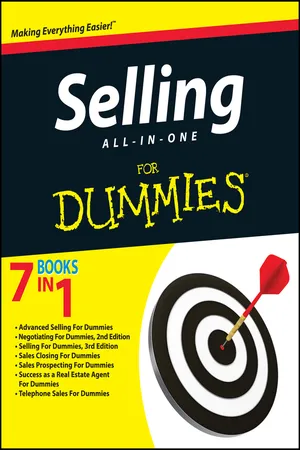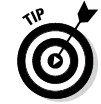Chapter 1
Becoming the Power Seller You Want to Be
In This Chapter
Drawing up and executing a sales plan
Enhancing your sales potential by studying new sales techniques
Overcoming roadblocks to reach an unlimited upside
Far too many salespeople resign themselves to what they consider is a painful reality — they can’t sell, because they have no customers to sell to. Mediocre salespeople constantly tell themselves, “If someone would just bring me a customer, I could sell.” They rely far too much on the company they work for to market the products and services.
Entrepreneurial salespeople, on the other hand, blame nothing — not the market, the product, the boss, or the company they work for. Instead, they drum up their own business. They make business happen. They become revenue-generating machines, no matter where they work or what they sell.
This chapter helps you lay the foundation for becoming a true power seller. Here, you discover how to create and implement a plan that strategically leads you to your sales goals, how to expose yourself to a variety of other sales strategies that can broaden your skills, and what you can do to overcome some obstacles that salespeople commonly face.
Charting Your Road Map to Sales Success
Success rarely happens by mistake. It requires planning, execution, and hard work. You set a goal, figure out how you’re going to get there, pull together everything you need to execute your plan, and then work your plan the best you can with the confidence of boosting sales and profits.
In this section, you chart the course to your sales success, draw up a list of tools and resources required, and formulate a clear idea of how you’re going to get from point A to point B. And if you happen to veer off course, this section shows you how to get back on track and perhaps even discover a couple of detours to shorten the journey.
Always be planning. Planning is always a necessity, whether you’re just starting out, have achieved some level of success, or recently suffered a setback. Effective planning assists you in achieving success, avoiding failure, and recovering from disappointments.
Drawing up your sales plan
Stop thinking of yourself as a salesperson or an employee. Instead promote yourself to entrepreneur. Regardless of whether you own your own business, you are a business, a revenue-generating entity . . . You, Inc. As such, one of your primary responsibilities is to draw up a business plan — in this case, a sales plan. You’re going to plot point A (current sales) and point B (your sale goal), and then chart the course that leads you from point A to point B.
Drawing up a sales plan is a seven-step process, explained in the following sections.
Your sales plan may not work out quite the way you expect it to, but the process of planning forces you to think about your goals and, more important, how you’re going to achieve those goals. Even if your plan is only 50 percent effective, that’s 50 percent better than having no plan.
Step 1: Determining where you are
You have to establish where you are in terms of sales and marketing efforts to figure out where you’re going in terms of sales, revenue, and growth. To get a clear idea of where you stand, jot down the following:
Current gross sales annually or, if you’re just getting started in selling or you’re in a new sales position, conservative goal for gross earnings.
Amount of time you typically invest in your business annually.
Sales-per-hour earnings: Divide your annual gross sales revenue by the number of hours you work per year.
Annual sales expenses, including your personal outlay for marketing materials, equipment, supplies, and so on.
Dollar investment per dollar of sales: Divide your annual sales expenses by your annual gross sales.
The most important numbers you jot down are your sales-per-hour earnings and dollar investment per dollar of sales. Think of these numbers as your
sales efficiency ratings. They’re sort of like golf scores — the lower the number, the fewer times you have to swing to score a sale. Track the numbers over time to measure your progress.
Step 2: Setting a goal
By their very nature, sales goals are production-based; as a salesperson, your goal is to sell more stuff. Determination, effort, and your engaging personality are certainly important, but unless they generate more revenue, they don’t really show up on the balance sheet at the end of the year.
When setting a sales goal, focus on increasing revenue. Here are a few examples of sales goals:
Increase gross sales by at least 20 percent.
Increase the net profit on products and services by at least 5 percent.
Line up 15 new customers.
Increase existing customer orders by 10 percent.
Note that these goals simply state the desired end result. They say nothing about how you’re going to achieve that goal or the amount of time you have to reach your goal. You can attend to these details later, as the following sections describe.
Don’t share goals with non-goal-setters, like your buddy who defines success as drinking a six-pack of beer every Friday night, or anyone who you aren’t sure will support your efforts to succeed. People who don’t set goals tend to put down those who do. They can kill your dreams.

















